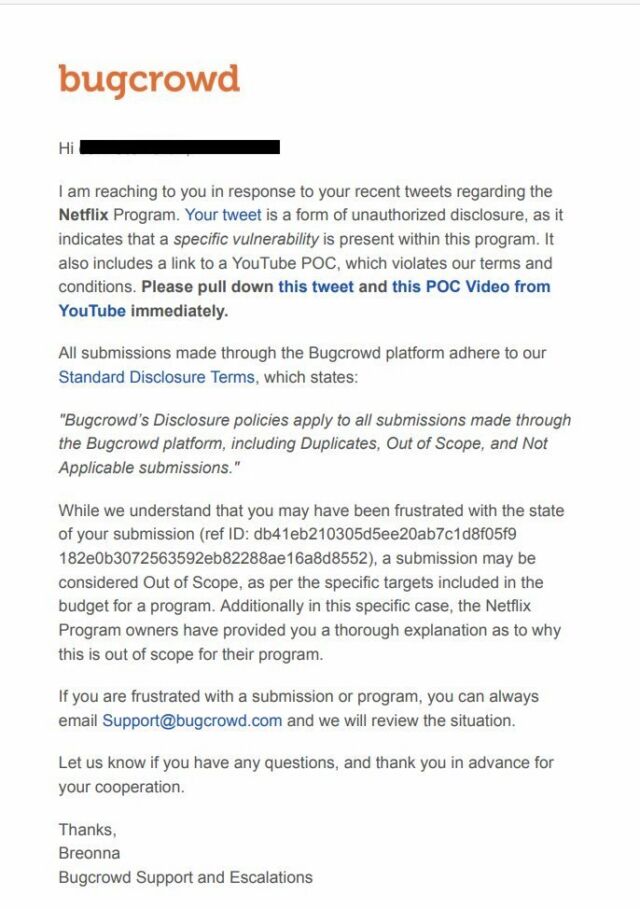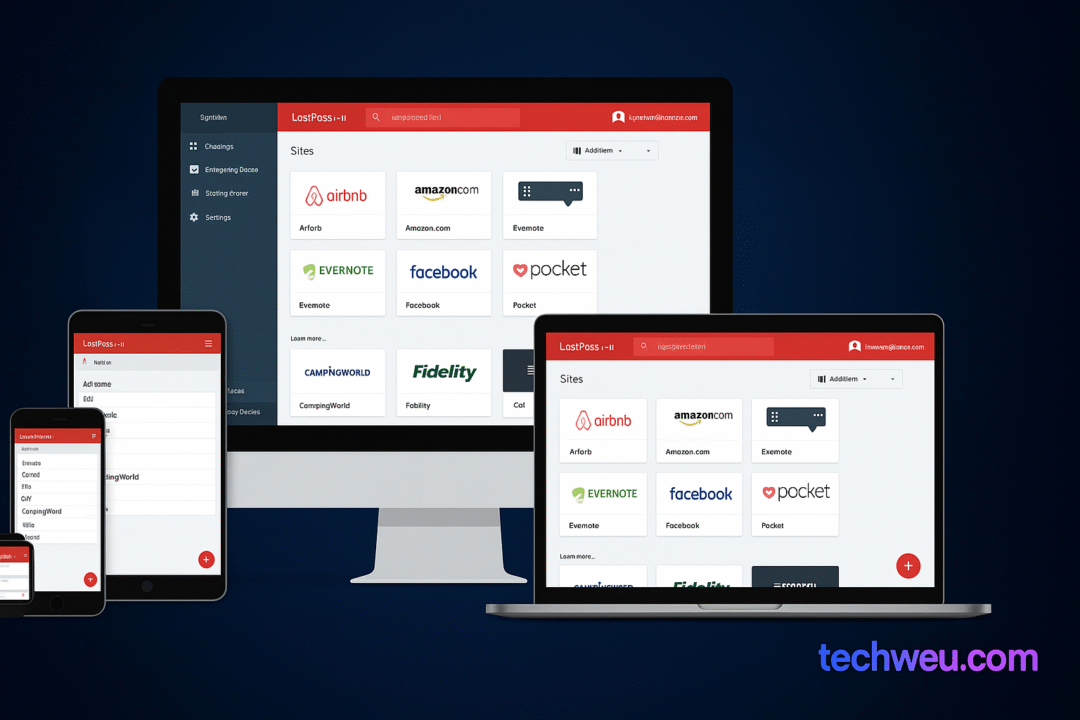Dan Goodin
Up-to-date 3/23/2020: A Netflix spokeswoman reported that the dismissal of this bug report on the grounds it was out-of-scope was a slip-up on the portion of the enterprise. The organization has given that confirmed the validity of the report and commenced rolling out a deal with on Friday. The spokeswoman reported that the researcher will obtain a bounty, whilst she didn’t say how a lot it will be. What follows is the authentic Ars report:
A Netflix stability weak spot that permits unauthorized entry to person accounts in excess of area networks is out of the scope of the company’s bug bounty system, the researcher who noted the danger reported. Even with dismissing the report, the Bugcrowd vulnerability reporting assistance is attempting to avoid community disclosure of the weakness.
The researcher’s evidence-of-principle exploit uses a classic male-in-the-middle assault to steal a Netflix session cookie. These browser cookies are the equivalent of a wristband that tunes venues use so paying out prospects aren’t billed an entrance rate a next time. Possession of a legitimate session cookie is all that’s demanded to obtain a target’s Netflix account.
Nevertheless unencrypted after all these several years
Varun Kakumani, the security researcher who learned the weak point and privately noted it by means of Bugcrowd, mentioned the attack is possible for the reason that of two points: (1) the ongoing use of crystal clear-text HTTP connections fairly than encrypted HTTPS connections by some Netflix subdomains and (2) the failure of Netflix to equip the session cookie with a secure flag, which prevents transmission over unencrypted connections.
The omissions are stunning to find in a important Net service in 2020. In the many years adhering to the 2013 revelations of indiscriminate spying by the Countrywide Protection Company, these services pretty much universally adopted the use of HTTPS throughout all subdomains. The protocol offers conclude-to-close encryption between web sites and stop users. Netflix didn’t answer to a information searching for remark for this post. With out an explanation from the firm, it’s not crystal clear if the use of plaintext connections is an oversight or completed purposely to offer various capabilities.
“Essentially you can hack any Netflix account [of] whoever is on the identical Wi-Fi community,” Kakumani told me. “Old-college MITM attack.”
Disclosure not permitted
He explained he described the menace by Bugcrowd, the vulnerability reporting services that Netflix uses to acquire disclosures from hackers and shell out them a reward in exchange. On March 11, Bugcrowd despatched Kakumani a reply that mentioned the weak point he claimed was out of scope with the bounty software. Bugcrowd went on to notify the researcher that its terms of support barred him from publicly disclosing or speaking about the weakness.
“This system does not permit disclosure,” the response mentioned. “You may not launch facts about vulnerabilities identified in this application to the public. This applies to all submissions regardless of status example: out of scope. The coverage is what you have agreed on submission. Thank you again and have a fantastic day!”
Kakumani overlooked the admonishment and disclosed the vulnerability on Twitter and posted video clips that showed in depth how his attack worked. A Bugcrowd employee working with the title Breonna replied with a information that stated, “Your tweet is a variety of unauthorized disclosure, as it signifies that a specific vulnerability is current within this program. It also features a backlink to a YouTube POC, which violates our conditions and ailments. You should pull down this tweet and this POC Video clip from YouTube quickly.”

Kakumani complied with the request. On Wednesday, seven times soon after sending the notification, Bugcrowd contacted Kakumani yet again to convey to him his report was dismissed for the reason that it was a copy of a earlier submitted report.
In a assertion, Bugcrowd officers wrote:
Public disclosure of vulnerabilities is a nuanced and remarkably contextual discussion. As an corporation, we strongly advocate for disclosure, and have designed performance into our system (CrowdStream) that is meant to aid both of those researchers and corporations work alongside one another to disclose conclusions.
Nonetheless, due to the character of stability vulnerabilities and likely threats of uncoordinated disclosure, various customers abide by the plan that something documented to the platform wants to be accepted by the client before it can be shared publicly. This will allow customers to deal with the vulnerability in advance of it is disclosed. It is entirely feasible that any report can arrive at this point out, so long as the researcher and the business coordinate their functions. In the function that a researcher posts information about a vulnerability without receiving consent from the organization that has not allowed disclosure, we work with the researcher to get rid of this details from public forums to secure the researcher and shopper.
We facilitate this through our platform and program supervisors. The specific target in reporting a vulnerability is for it to get remediated, and to make the entire world a small a lot more safe.
Disclosure isn’t barred in perpetuity. We strongly advocate for disclosure as much as possible—it’s good for the group, and following getting mounted, it reveals the safety-forwardness of the group remediating the problem. Nevertheless, it really is vital that the disclosure comes only after a discussion among the researcher and customer’s plan homeowners so that both equally events achieve a mutually agreeable disclosure timeline, etc. In most scenarios, in which you will find a discussion, an agreeable result is normally arrived at, and all get-togethers appear away with a gain (the firm is aware about and fixes the getting the researcher receives paid, and is able to disclose on a timeline immediately after the situation is preset and buyers are not positioned at needless danger owing to unauthorized disclosures). Our system with CrowdStream capabilities and software teams permit this interaction.
As described previously, the cookie theft demands the attacker and target to hook up to the same Wi-Fi entry point or other local community. The unauthorized obtain also requires that the concentrate on be logged in to his or her Netflix account. The attacker makes use of a strategy known as ARP poisoning to intercept the site visitors among the goal and Netflix and then move it alongside to the other party. The attacker then waits for the concentrate on to make an HTTP connection to any area. At the time the unencrypted link is recognized, the attacker injects HTML into the link to build a second connection request to a person of the Netflix HTTP subdomains, this kind of as oca-api.netflix.com.
The relationship to the HTTP subdomain can make NetflixId—the title of the unprotected session cookie—free for the having. If targets you should not entry an HTTP relationship on their individual (something that’s more and more popular since HTTPS is just about ubiquitous these times) an attacker can trick targets into clicking on any HTTP connection. The moment in possession of the cookie, the attacker then uses a browser console to paste the cookie on an open up Netflix webpage. With that, the attacker accesses the target’s account.
A transcript of Kakumani’s communications with Bugcrowd reveals a worker for the vulnerability reporting assistance indicating that possession of the NetflixID cookie was not adequate to obtain unauthorized access to an account. As an alternative, the employee explained, “This assault would involve a person-in-the-middle posture and does not compromise the SecureNetflix cookie, which is employed to authenticate a user to www.netflix.com. The SecureNetflix cookie has the Protected flag set and will never be sent about an unencrypted channel. The NetflixId cookie does not have the Secure flag established but involves the SecureNetflix cookie to authenticate a user.”
Kakumani explained to me the worker’s assertion is erroneous, and his evidence-of-concept films, which at Bugcrowd’s insistence are no extended general public, seem to be to show this. The videos exhibit the attacker working with only the NetflixId cookie to obtain access to an account.
In any celebration, attackers who achieve unauthorized accessibility won’t be able to take around the account, because changing passwords or affiliated e-mail addresses demand information of the existing password. Attackers, even so, can continue to view videos and check out a target’s enjoy background, phone number and other own details. Attackers can also modify programs to ultra higher definition, which fees a lot more than higher definition. The unauthorized obtain is feasible even when the focus on logs out of the account or can make a password modify on the exact unit that received the intercepted session cookie, Kakumani stated.
Exploit is not for every person
Provided the prerequisites that the attacker need to be on the same area network as the focus on and need to both trick the focus on to click on on an HTTP connection or wait around for the focus on to entry one particular on his or her personal, there’s minimal likelihood that this weak spot will be greatly exploited. Nevertheless, the vulnerability offers an option for qualified attacks in a state of affairs that takes place frequently. It’s surprising that Netflix, a business with a moderately great safety keep track of report, would dismiss Kakumani’s report.
The incident also underscores the function bug-bounty packages perform in squashing vulnerability disclosure. No doubt, privateness will make sense when corporations are in the process of fixing a vulnerability. The secrecy stops other hackers from maliciously exploiting the weaknesses right before the repair is in put.
But after a weakness is fixed—or in the party a corporation opts not to repair it—users deserve to have total facts of the bug, together with how attacks do the job. Bugcrowd insurance policies barring the free move of this data provide the passions of Netflix but are a lot less helpful to the community at massive.




